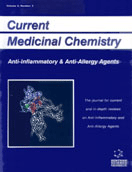Abstract
Some medicinal plants, which are known to produce allergic reactions, are also specifically used as antiinflammatory agents. Among the more relevant plants, we report species with cinnamaldehyde, cinnamic alcohol, geraniol, hydroxycitronellal, eugenol and isoeugenol are all potential allergens. In addition, fragrances, which are mixtures of small-molecular-weight compounds, may induce allergic contact dermatitis due to fragrance-specific CD4+ and CD8+ T lymphocytes. Plants from the Asteraceae family used in folk medicine as anti-inflammatories can cause allergic contact dermatitis because of its content in sesquiterpene lactones, which have been reported as the antiinflammatory principles in this species. Species with flavonoids, iridoids, terpenoids and alkaloids have been described as inhibitors of contact dermatitis. Scrophularia auriculata, Poria cocos, Santolina chamaecyparissus, Ranunculus sceleratus and Helichrysum italicum all showed activity in different experimental protocols of contact dermatitis, thus justifying the potential use of these medicinal plants as anti-allergens and inhibitors of contact dermatitis reactions produced by allergens and chemicals. Hydroquinone derivatives such as 1-O-b-glucopyranosyl-2-(3-hydroxymethyl-3-methylallyl) hydroquinone and arbutin, flavonoids such as kaempferol, apigenin and genistein, sesquiterpene lactones such as helenalin, diterpenes such as triptonide, triterpenes such as tripterine and bryonolic acid, iridoids such as scrovalentinoside, alkaloids such as indirubin, dehydrocorydaline, magnoflorine hydroxide and phellodendrine acetate, and polysaccharides such as fucoidin have been reported as inhibitors of contact dermatitis reactions.
Keywords: contact dermatitis, anti-allergenic, medicinal plants, natural products, phenolics, flavonoids terpenoids, alkaloids
 32
32

